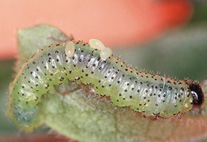Abstract
Adelognathus leucotrochi Shaw & Wahl sp. nov. is described from Britain where it is a univoltine slightly gregarious koinobiont ectoparasitoid of late stage larvae of the tenthredinid sawfly Nematus leucotrochus Hartig feeding on Ribes uva-crispa. Defensive reactions by the host to prospecting females are described. The developmental biology of A. leucotrochi is described in detail: the host is only temporarily paralysed by the injection of a venom that has no other effect on the host, and eggs are laid on the host’s dorsum without involvement of the ovipositor—that is, the egg issues direct from the genital opening. Prior to oviposition the adult female parasitoid prepares the site by spreading an adhesive substance from her ovipositor. Host-feeding by adult females occurs on haemolymph and sometimes also other tissues obtained at the site of a wound made always by the mandibles, but appears not to be obligatory. It may be concurrent or non-concurrent with oviposition; in the latter case, it may be either destructive or non-destructive. Larval development is very rapid, taking about 70 hr at 18–22ºC, and the host continues to feed for approximately the first half of this period. Five larval instars were detected, and their cephalic sclerites are described and illustrated, as are those of the final instars of a further three species of Adelognathus for comparison. The rather featureless final instar larva is also figured, as is the tough cocoon in which the winter is passed as a prepupa. The biology of some idiobiont Adelognathus species is discussed in comparison with that of A. leucotrochi, and several other instances of eggs not issuing from the ovipositor in non-aculeate ectoparasitoid Hymenoptera, whether koinobionts or idiobionts, are briefly reviewed. It is concluded that this habit seems to arise rather easily when there is direct bodily contact between the adult and the host/prey, as indeed is the case in all carnivorous aculeates that do not practice continuous provisioning.

